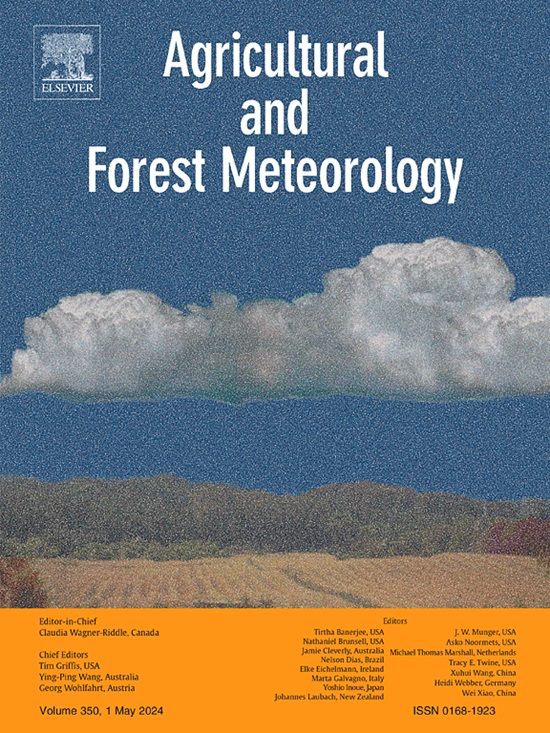确定欧洲山毛榉树种南部分布区气候生长模式及其季节性的单树方法
IF 5.7
1区 农林科学
Q1 AGRONOMY
引用次数: 0
摘要
欧洲南部干燥和温暖的气候条件代表了欧洲山毛榉(Fagus sylvatica)在物种南部分布极限附近生长的明显限制,但目前尚不清楚干旱化和季节性降水制度的变化将如何在个体水平上影响这些森林。我们通过广义线性混合模型(glmm),利用欧洲南部和东南部的日常气候数据和大量树木年轮宽度序列,探索了欧洲山毛榉的气候增长关系和峰值气候信号的季节性。在大多数情况下,降水量对树木生长有显著的正向影响,而最高温度对树木生长有显著的负向影响。glmm的预测显示,从春季到初夏(4月中旬到7月中旬)的88天窗口内,对我们网络中平均树木的降水产生了积极影响。这个关键的生长时间窗口在温暖和干燥的条件下为75天,在气温温和和夏季降水适中的地区延长至100天。夏季(6 - 7月)最高气温对树木的负面影响平均为27天。在夏季潮湿和寒冷的地区,这段时间减少到10天,在夏季干燥和温暖的地区,这段时间增加到45天。在较大的树木中,降水对生长的积极影响更强,开始得更早。同样,最高温度的负面影响对较大的树木更为明显。使用每日气候数据和以树为中心的方法可以捕捉气候增长关系中的关键时间动态,而这些动态常常被传统方法所忽视。这些发现大大增强了我们对影响山毛榉分布范围边缘个体生长及其季节变化的气候因素的理解。本文章由计算机程序翻译,如有差异,请以英文原文为准。


A single-tree approach to determine climate-growth patterns of European beech and their seasonality in the species southern distribution area
Dry and warm climate conditions in southern Europe represent clear limits for European beech (Fagus sylvatica) growth near the species southern distribution limit, but it is unclear how aridification and changes in seasonal precipitation regimes will affect these forests at the individual level. We explored climate-growth relationships and the seasonality of peak climate signals in European beech using daily climate data and a large collection of tree-ring width series from southern and southeastern Europe through Generalised Linear Mixed Models (GLMMs). In most cases we found a positive and significant influence of precipitation on tree growth, and a significant negative effect of maximum temperature. Predictions from the GLMMs revealed a positive impact of precipitation during an 88 day window from spring to early summer (mid-April to mid-July), for an average tree across our network. This critical growing time window ranged from 75 days in warmer and drier conditions, and extended up to 100 days in areas with mild temperatures and moderate summer precipitation. Maximum temperatures negatively affected trees for an average of 27 day window in summer (June-July). This period was reduced to <10 days in locations with wetter and colder summers, rising up to 45 days in sites with drier and warmer summers. The positive effect of precipitation on growth was stronger and commenced earlier in larger trees. Similarly, the negative effects of maximum temperatures were more pronounced for larger trees. The use of daily climate data and a tree-centred approach allowed for capturing critical temporal dynamics in climate-growth relationships that are often overlooked by conventional methods. These insights significantly enhance our understanding of climatic factors influencing individual beech growth at the edge of its distribution range and their seasonal variations.
求助全文
通过发布文献求助,成功后即可免费获取论文全文。
去求助
来源期刊
CiteScore
10.30
自引率
9.70%
发文量
415
审稿时长
69 days
期刊介绍:
Agricultural and Forest Meteorology is an international journal for the publication of original articles and reviews on the inter-relationship between meteorology, agriculture, forestry, and natural ecosystems. Emphasis is on basic and applied scientific research relevant to practical problems in the field of plant and soil sciences, ecology and biogeochemistry as affected by weather as well as climate variability and change. Theoretical models should be tested against experimental data. Articles must appeal to an international audience. Special issues devoted to single topics are also published.
Typical topics include canopy micrometeorology (e.g. canopy radiation transfer, turbulence near the ground, evapotranspiration, energy balance, fluxes of trace gases), micrometeorological instrumentation (e.g., sensors for trace gases, flux measurement instruments, radiation measurement techniques), aerobiology (e.g. the dispersion of pollen, spores, insects and pesticides), biometeorology (e.g. the effect of weather and climate on plant distribution, crop yield, water-use efficiency, and plant phenology), forest-fire/weather interactions, and feedbacks from vegetation to weather and the climate system.

 求助内容:
求助内容: 应助结果提醒方式:
应助结果提醒方式:


